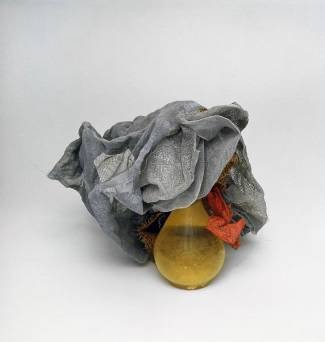Helio Oiticica
dal 13/12/2006 al 31/3/2007
Segnalato da
13/12/2006
Helio Oiticica
Museum of Fine Arts MFAH, Houston
The Body of Color

The Body of Color
The Body of Color traces the conceptual and technical processes that led to Oiticica's emancipation of color into space. The exhibition displays the different series created throughout the artist's career, shedding light on the various contexts and influences that nurtured their production, and demonstrating the rigor of his aesthetic inquiry. In an attempt to stay true to the broad inter-disciplinary scope of Oiticica's production, the exhibition also includes documentary materials, sketches, journals, plans, films, and maquettes. Because the artist was a meticulous record keeper and would not sell his work, the PHO possesses an astonishing amount—about 95 percent—of Oiticica's lifetime production, as well as an unprecedented wealth of supporting material.
The Body of Color will bring to light an, until now, little explored dimension of Oiticica's work that will complement, if not correct, the prevailing view of the artist as an anti-art practioner operating in and from the Brazilian margins. On one hand, the organization and digitization of the artist's voluminous archives undertaken as part of the Catalogue Raisonne' project has made possible a fresh approximation to his work through writings, clippings, and meticulously annotated journals and work notebooks. Interviews with family members have also thrown light on the relationship between Jose' Oiticica's work with black and white abstract photography and his son's early chromatic structures. On the other hand, materials analysis of the painted series has revealed Oiticica as a pioneer in the use of synthetic polymer medium which he applied according to complex color theories and his manipulation of very traditional painting methods. Oiticica's early series also belie a deep interest in geometry and the golden section which he used to structure what, on first sight, appear to be quickly assembled and improvised constructions. All of these elements serve to establish the artist's affinities with early masters of modern art like Paul Klee, Piet Mondrian, Kasimir Malevich and Marcel Duchamp as well as the ways in which he departed from their forms of Modernism in search of his own creative path.
Oiticica's exploration of color began with the early paintings and gouaches that he did with the Rio de Janeiro-based Grupo Frente (1955-56). This early series (never shown before) already reveals a highly subjective (even subversive) approach to the concrete art tradition inherited from Mondrian. The iconoclastic approach of the Grupo Frente led to the initial deconstructions of color grids embodied in the Secos and Metaesquemas (1957-58) series. It also resulted in an extraordinary group of white on white paintings—never seen during the artists' lifetime or afterwards and only recently restored for this exhibition—inspired by Malevich. In 1959, after joining the Neoconcrete Group that already included Lygia Clark and the poet and theoretician Ferreira Gullar, Oiticica explored the retinal and physical experience of color in non-traditional paintings and objects that invited the participation of the viewer. Following the phenomenological theories of Merleau-Ponty, their work during this period resulted in the progressive deconstruction of the traditional components of painting—i.e. color and its support, the two-dimensional plane—and their reconfiguration in innovative proposals. Hence, in Oiticica's Spatial Reliefs, Bilaterais (1959) and Nuclei series (1960-66)—which consist of suspended painted-wood constructions—the spectator is invited to move in and around the panels to discover color as a physical body or environment. Shortly afterwards, Oiticica started to work with ephemeral materials becoming progressively interested in incorporating the viewer into the work of art as a dynamic component. In this period he constructed Penetrables (1960-79), environmental pieces consisting of labyrinths in which the audience was invited to walk and experience sensations through bodily contact with ropes, hanging fabrics, plants, sand, gravel, and everyday life objects.
However, it was not until the Bolides (1963-69) and Parangole's (1964-79) that Oiticica's exploration of color and color theories achieved a highly radical and original formulation that set him firmly apart from his predecessors and contemporaries. The Bolides consisted of glass containers and wood boxes filled with pigments, coal, shells and earth. On one hand, these were meant to produce an "energetic" encounter between the body and the psyche of the viewer by means of a direct visual and tactile stimuli; on the other hand, when exposed to light, they produced subtle chromatic effects that situate them in the category of manipulable light-boxes. With these objects, Oiticica began the gradual dematerialization of color into pure sensory stimuli which would reach a climax with the Parangole's (1964-79). The latter consisted of colored capes, banners and cloth-objects to be displayed or worn as "habitable" paintings by the public. Worn by anonymous members of the audience who moved to the rhythm of samba, the Parangole's functioned to activate and enact the fleeting illusion of "color-in-motion."
Image: He'lio Oiticica, Brazilian, B17 Glass Bo'lide 05 "Homenagem a Mondrian", 1965
This exhibition will travel to the Tate Modern, June 7-September 23, 2007.
Major corporate sponsorship is provided by PETROBRAS.
Additional generous funding is provided by:
The Bruce T. Halle Family Foundation
The Andy Warhol Foundation
Sotheby's
Fulbright & Jaworski L.L.P.
Samuel F. Gorman
Opening December 14, 2:00 PM - 4:00 PM
The Museum of Fine Arts Houston
Caroline Wiess Law Building
1001 Bissonnet Street - Houston
Hours:
Tuesday, Wednesday 10:00 a.m.-5:00 p.m.,
Thursday 10:00 a.m.-9:00 p.m.,
Friday, Saturday 10:00 a.m.-7:00 p.m.,
Sunday 12:15 p.m.-7:00 p.m.
Closed Monday, except Monday holidays.
Closed Thanksgiving Day and Christmas Day



